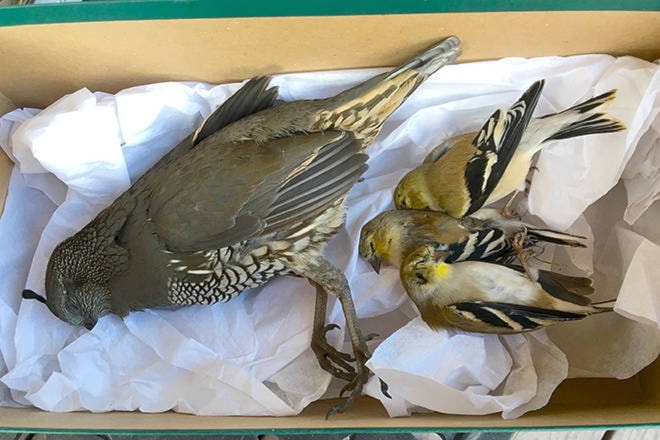It seems that even everyday objects can have unforeseen impacts. A window can be a catastrophic barrier for our feathered friends.
From a bird perspective, windows are either invisible or a mirror that reflects the natural scenery. Bright days and open landscapes make this mirror effect especially visible. Winter light and reflections can also be extremely disorienting.
The dull thunk of a bird hitting a window happens much too often. If a bird hits with a glancing blow it might sit for a time, allowing its body to recover, then fly off.
On the other hand, when fleeing a predator bird, a window strike can be deadly. The victim can hit a window at speeds of 60 km/h or more. Even a small American goldfinch streaks away at that speed.
In a steep attack dive a Peregrine falcon can blast into hyper drive clocked at over 300 km/h.
A few years ago, a frightening crash signalled a bird strike beyond anything I’d heard before. A ruffed grouse had struck a window that seemed to offer a clear route through to an opposite window. At its top escape speed, 40 km/h, the grouse died instantly and broke the seal on a large double paned window. An expensive interaction for both of us!
According to Nature Canada’s website, “Environment Canada ranked window collisions as the second highest direct human cause of bird deaths in Canada, estimating that 16 million to 42 million birds die from window collision annually in Canada. Ninety percent of these collisions are with windows in individual houses, about 9 per cent from low-rise buildings, and less than one per cent from high rises and skyscrapers.”
Bird deaths due to window collisions are so predictable, predator birds make a habit of scanning likely collision sites.
What to do? I found a bird strike prevention ad for clear spider web decals. Ever the economizer, I simply drew lots of spider webs with a silver Sharpie pen. From the inside the webs are barely visible but they are bright from the outside. Of course any liberally applied decal will work and they’re available as seasonal designs, such as snowflakes!
A recent Facebook posting shocked me.
A sharp shinned hawk had attacked a flock of American goldfinches.
Their escape route drove them directly into a glass deck railing. The photos told the story. Not only were there a number of goldfinches killed by the unexpected barrier, the hawk had followed its victims right into the same glass railing. All had died.
Within days, a number of other birds had succumbed to the same glass deck railing including a California quail and three American goldfinches.
Unable to add decals to the glass railing as it was on an unattended nearby property, the observer came up with the only available solution.
They removed their own bird feeders so fewer birds would be attracted into the danger zone.
Reports indicate that bird strikes have been reduced.
Nature Canada makes a similar suggestion with a reminder that bird feeders should not be placed within one to five metres of a glass surface.
Of course these distressing events are influenced by many factors… time of day, angle of the sun, weather conditions, interior household and building lighting, overall building design, landscape setting, seasonal changes in bird populations, and migration patterns.
Are there choices we can make to give birds a better chance? Are there trees and bird feeders near windows? Are there lots of decals on windows and glass balconies to make them more visible?
Notice the windows and glass surfaces around your home. Think how a bird sees them to help them survive.
Dianne Bersea is a member of the South Okanagan Naturalists.
